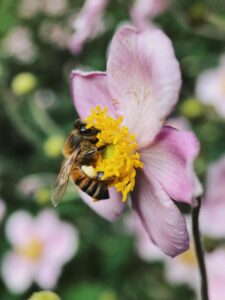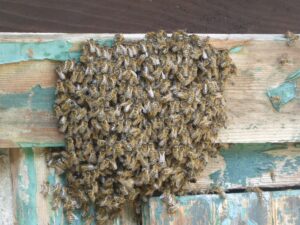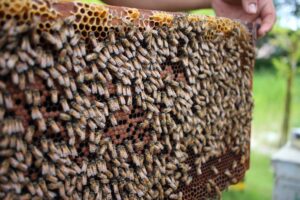With the turn of the year, we find ourselves on the tail end of winter here in Oregon. That doesn’t mean it’s going to get nice out, we still have months of rain ahead of us. However, it does mean that were going to start getting some warmer days occasionally. String a few warm days together and things start waking up. Creatures start poking their noses (snouts…proboscises?) out of their winter hideaways wondering, “is it spring yet?”
This can lead to all sorts of pest control issues and many new clients for us. However, sometimes it’s not about chasing the dollar…sometimes it’s about protecting our environment. Not all bugs are actually bad and some we couldn’t live without. I’m talking about pollinators! Specifically, bees of the honey variety because there are a ton of pollinators and I’m not about to waste my time advocating for mosquitoes.

Image by Aaron Burden
As I write this it’s January 27th and I’m already seeing hive activity on the beekeeper groups I follow on Facebook . Videos of workers entering and leaving their box, making honey while the sun shines, so to speak.
Honeybees are an industrious social insect with a colony consisting of one queen, drones (male bees), and workers (sterile females). They create an elaborate hive of hexagonal cells, called comb, out of wax. Into some of these cells the queen lays her eggs and these are referred to as “brood cells”, existing to build the colony size. In the rest of the cells the bees store all the excess nectar that they collect, this is their store of food for the winter when resources are scarce, and temperatures are too low to forage.
When a hive is successful, and they start to outgrow their home and the resources around it the colony may split itself in two in a process called swarming. To prepare for swarming the bees will construct special cells called queen cells. Into these cells will go fertilized eggs and the pupae will be fed a special diet to create female bees capable of laying fertilized eggs.
The current queen will then be fed much less food to slim down in preparation for flight. I do the same thing before flying to a destination that requires board shorts.
When the queen is ready, and the successors are in place, and the scouts have chosen a new location the worker bees will chase the old queen out of the hive then follow her out in a massive cloud of thousands of bees. Roughly half the workers will leave with the old queen leaving the other half to release its new queen and continue on in their original location.
This is usually the point in the process where we start getting calls. Gigantic clouds of noisy buzzing stinging insects tend to draw attention. The swarm will follow its queen to a nearby rally point, usually a nearby branch, but sometimes it’s something more interesting like a BBQ or a pickup truck. The workers will surround the queen to keep her safe creating a massive ball of bees. This is usually a temporary resting spot, and the swarm may make several stops before arriving at its final location for the new hive.
So, what to do if you find one of these bee balls?
Though intimidating, swarming bees are usually non-aggressive and won’t attack unless threatened. Just keep your distance and they

Image by Steve Sharp
will probably move on to a new location soon. If it’s a safety issue its best to contact your local beekeeper’s association, here it’s the Willamette Valley Beekeepers Association, but all areas will have one. They can almost always put you in contact with somebody who will come and happily collect the swarm, usually free of charge. Win-Win!
Unfortunately, it’s not always win-win. Sometimes this swarm moves toward an end point, and the final destination is a gap in the soffit of your eaves, or a crack in the siding. And before you know it, the bees establish a hive in the wall voids of your home.
What are the signs of honeybees nesting in your home?
I’m glad you asked:
- Bees entering and exiting the exterior of your home.
- A high level of bee activity specific to one area or side of your home.
- Bees on the inside your home regularly, particularly in late winter/early spring.
- Buzzing sounds.
- Dark patches on the walls or ceilings.
So…you’ve established that the bees are nesting in your walls, now what?
Please DO NOT start spraying them with pesticides. Even if you do kill all the bees (which would be a tragedy) the nest material would remain.
That nest is made of wax, and that wax is full of honey, and when the hive is active the bees use their wings to regulate the temperature inside their home. With the bees all gone that climate control is gone and when it gets hot outside that wax will melt, releasing all the honey to soak into the structure, staining the walls and attracting any number of other pests into your home for the food source.
That honeycomb has to be removed one way or another so I’d advise taking the responsible route and hiring a contractor that will work with the beekeepers to open the wall and remove the hive keeping all the bees healthy. Then you can make any repairs that you need to and also seal up the entrance from the outside. It’s not free, but it certainly beats honey seeping out from underneath your baseboards, or the ants, moths, beetles, wasps, flies, and rodents that follow.

Image by Steve Sharp
If you call us, we may come out to assess the situation, but we won’t be treating for honeybees at all. Swarms are super cool though! We would definitely check it out, probably take a few pictures, some selfies, #GiantballObees, and then give you some good advice and a couple phone numbers. We want to keep these ladies safe because without them, people are going to get mighty hungry, mighty fast. Here at Good Earth, we believe in responsible pest control and protecting our bees, so if you’re looking for somebody to exterminate them, you can just… buzz off.
Thank you, I’ll see myself out,
Adam Hiddleson



